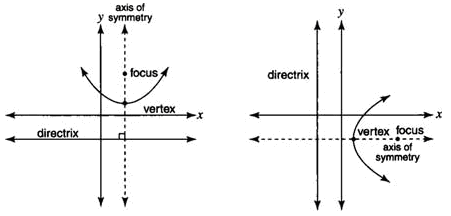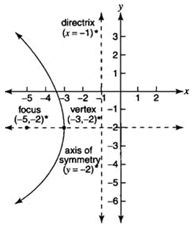Parabolas
| Site: | Clare-Gladwin RESD |
| Course: | Michigan Algebra II KHauck |
| Book: | Parabolas |
| Printed by: | Guest user |
| Date: | Friday, December 19, 2025, 11:28 PM |
Description
Parabolas
Parabolas
Parabolas were previously presented in function form. This book will introduce the conic section applications of parabolas. The connection to conic sections will not change the characteristics of parabolas. However some may seem new.A parabola is the set of points in a plane that are the same distance from a given point and a given line in that plane. The given point is called the focus, and the line is called the directrix. The midpoint of the perpendicular segment from the focus to the directrix is called the vertex of the parabola. The line that passes through the vertex and focus is called the axis of symmetry.

Opens Vertically
The equation of a parabola with vertex at (h, k) that opens in the "y-direction" is y = a(x - h)2 + k. The direction of opening is determined by the value of a. If a < 0, it will open down. If a > 0, it will open up. This form is exactly the same as a translated parabola from previous lessons. These parabolas will have the following properties:Opens Horizontally
The equation of a parabola with vertex at (h, k) that opens in the "x-direction" is x = a(y - k)2 + h. The direction of opening is determined by the value of a. If a < 0, it will open to the left. If a > 0, it will open to the right. These parabolas will have the following properties:Focus: ![]()
Directrix: ![]()
Axis of symmetry: ![]()
Example 1
Graph the parabola below. State which direction the parabola opens and determine its vertex, focus, directrix, and axis of symmetry.
Symmetry
Parabolas have reflectional symmetry, no rotational symmetry. The reflectional symmetry depends on the orientation of the parabola. If the parabola is vertical, then the line of symmetry is vertical through the vertex. If the parabola is horizontal, then the line of symmetry is horizontal through the vertex.
Example State the symmetry for the parabola modeled by the equation:
![]()
Step 1. State the vertex.
The vertex of the parabola is: (5, 2)
Nonstandard Form
If the equation is not given in standard form, it will need to be converted to standard form by completing the square. To identify an equation as a parabola, it will contain only one squared term as in the example below.Example Convert the equation below to standard form. State which direction the parabola opens and determine its vertex, focus, directrix, and axis of symmetry.
Factor the leading coefficient from the y group; x - 11 = 5(y2-6y)
Complete the square for y; x - 11 + (5?9) = 5(y2-6y+9)
Simplify; x = 5(y-3)2 - 34
Video Lessons
To learn how to graph parabolas, select the following link:Graph Parabolas
To learn how to write the equation of a parabola, select the following link:
Equation of a Parabola
Interactive Activity
ParabolasGuided Practice
To solidify your understanding of graphing and writing equations of parabolas, visit the following link to Holt, Rinehart, and Winston Homework Help Online. It provides examples, video tutorials and interactive practice with answers available. The Practice and Problem Solving section has two parts. The first part offers practice with a complete video explanation for the type of problem with just a click of the video icon. The second part offers practice with the solution for each problem only a click of the light bulb away.Guided Practice
Practice
Parabola WorksheetVideo Lesson:Â To see more examples on parabolas, view the video below.
Answer Key
Answer Key for Parabola WorksheetSources
Sources used in this book:CliffsNotes.com. Parabola. 28 Jul 2010 <http://www.cliffsnotes.com/study_guide/topicArticleId-38949,articleId- 38942.html>.
Green, Larry. "The Standard and General Form of a Parabola." http://www.ltcconline.net/greenl/java/IntermedCollegeAlgebra/StandardGen eral/StandardGeneral.html (accessed 7/27/2010).
Holt, Rinehart & Winston, "Conic Sections ." http://my.hrw.com/math06_07/nsmedia/homework_help/alg2/alg2_ch10_05_ homeworkhelp.html (accessed 7/27/2010).
Kenny Felder, "Conic Concepts -- Circles," Connexions, March 22, 2010, http://cnx.org/content/m18245/1.3/.